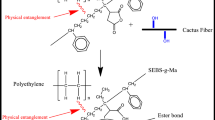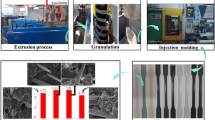Abstract
Recycled polyethylene terephthalate (rPET) used as an alternative reinforcing additive for polypropylene (PP) based composite fibers, compared with liquid crystalline polymer (LCP), was investigated. Both PP-LCP and PP-rPET composites were prepared as fiber using hot drawing process. The effects of draw ratios and compatibilizer dosages on morphology in relation to tensile properties of both types of the composite systems were studied. The variation of draw ratios resulted in much change of stress–strain behavior in compatibilized rPET composite system owing to the obvious difference in morphological change of rPET dispersed phase upon drawing. Tensile strength and extensibility of both composites system were significantly improved with compatibilizer loading. The tensile strength of compatibilized rPET-composite fibers was higher than that of the compatibilized LCP system. The obtained results demonstrated the high potential of rPET as a well-defined reinforcing material for PP based composite fiber under the improved interfacial adhesion promoted by compatibilizer.













Similar content being viewed by others
References
Kiss G (1987) In situ composites: blends of isotropic polymers and thermotropic liquid crystalline polymers. Polym Eng Sci 27:410–423
Acierno D, Collyer AA (1996) Rheology and processing of liquid crystal polymers. 1st ed. Polymer liquid crystal series, Vol.2. Chapman & Hall, London
Isayev AI, Modic M (1987) Self-reinforced melt processible polymer composites: extrusion, compression, and injection molding. Polym Compos 8(3):158–175
Mehta A, Isayev AI (1991) The dynamic properties, temperature transition, and thermal stability of poly(ether ether ketone)-thermotropic liquid crystalline polymer blends. Polym Eng Sci 31(13):963–970
Tjong S (2003) Structure, morphology, mechanical and thermal characteristics of the in situ composites based on liquid crystalline polymer and thermoplastics. Mater Sci Eng R41:1–60
Saikrasun S, Limpisawasdi P, Amornsakchai T (2009) Comparative study on phase and properties between rPET/PS and LCP/PS in situ microfibrillar-reinforced composites. J Polym Res 16:443–454
Saikrasun S, Limpisawasdi P, Amornsakchai T (2009) Effect of LCP and rPET as Reinforcing Materials on Rheology, Morphology, and Thermal Properties of in situ Microfibrillar-Reinforced Elastomer Composites. J Appl Polym Sci 112:1897–1908
Kalfoglou NK, Skafidas DS, Sotiropoulou DD (1994) Compatibilization of blends of poly(ethylene terephthalate) and linear low density polyethylene with the ionomer of poly(ethyleneco-methacrylic acid). Polymer 35:3624–3630
Aglietto M, Coltelli MB, Savi S, Lochiatto F, Ciardelli F, Giani M (2004) Postconsumer polyethylene terephthalate (PET)/polyolefin blends through reactive processing. J Mater Cycles Waste Manag 6:13–19
Friedrich K, Evstatiev M, Farikov S, Evstatiev O, Ishii M, Harrass M (2005) Microfibrillar reinforced composites from PET/PP blends: processing, morphology and mechanical properties. Compos Sci Technol 65:107–116
Taepaiboon P, Junkasem J, Dungtungee R, Amornsakchai T, Supaphol P (2006) In situ microfibrillar reinforced composites of isotactic polypropylene/recycled poly(ethylene terephthalate) system and effect of compatibilizer. J Appl Polym Sci 102:1173–1181
Fuchs C, Bhattacharyya D, Fakirov S (2006) Microfibrillar reinforced polymer-polymer composites: application of Tsai-Hill equation to PP/PET composites. Compos Sci Technol 66:3161–3171
Santos P, Pezzin SH (2003) Mechanical properties of polypropylene reinforced with recycled-PET fibers. J Mater Process Technol 143–144:517–520
Evstatiev M, Fakirov S, Krasteva B, Friedrich K, Covas JA, Cunha AM (2002) Recycling of poly(ethylene terephthalate) as polymer-polymer composites. Polym Eng Sci 42:826–835
Pawlak A, Morawiec J, Pazzagli F, Pracella M, Galeski A (2002) Recycling of postconsumer poly(ethylene terephthalate) and high density polyethylene by compatibilized blending. J Appl Polym Sci 86:1473–1485
Avila AF, Duarte MV (2003) A mechanical analysis on recycled PET/HDPE composites. Polym Degrad Stab 80:373–382
Zhang H, Guo W, Yu Y, Li B, Wu C (2007) Structure and properties of compatibilized recycled poly(ethylene terephthalate)/linear low density polyethylene blends. Euro Polym J 43:3662–3670
Evstatiev M, Fakirov S (1992) Microfibrillar reinforcement of polymer blends. Polymer 33:877–880
Bataille P, Boisse S, Schreiber HP (1987) Mechanical properties and permeability of polypropylene and poly(ethylene terephthalate) mixtures. Polym Eng Sci 27(9):622–626
Jayanarayanan K, Thomas S, Joseph K (2011) In situ microfibrillar blends and composites of polypropylene and poly (ethylene terephthalate): Morphology and thermal properties. J Polym Res 18:1–11
Xanthos M, Young MW, Biesenberger JA (1990) Polypropylene/polyethylene terephthalate blends compatibilized through functionalization. Polym Eng Sci 30(6):355–365
Chiu H-S, Hsiao Y-K (2006) Compatibilization of poly(ethylene terephthalate)/polypropylene blends with maleic anhydride grafted polyethylene-octence elastomer. J Polym Res 13:153–160
Heino M, Kirijava J, Heitoaja P, Seppala J (1997) Compatibilization of polyethylene terephthalate/polypropylene blends with styrene-ethylene/butylene-styrene (SEBS) block copolymers. J Appl Polym Sci 65:241–249
Sombatdee S, Saikrasun S, Amornsakchai T (2009) Phase behavior and thermal characteristics of polypropylene in situ microfibrillar-reinforced with liquid crystalline polymer and recycled PET. J Reinf Plast Compos 18(24):2983–2998
Lei Y, Wu Q, Zhang Q (2009) Morphology and properties of microfibrillar composites based on recycled poly(ethylene terephthalate) and high density polyethylene. Composites A 40:904–912
Incarnato L, Scarfato P, Maio LD, Acierno D (2004) Structure and rheology of recycled PET modified by reactive extrusion. Polymer 41:6825–6831
Carté TL, Mont A (1993) Morphological origin of super toughness in poly(ethylene terephthalate)/polyethylene blends. J Appl Polym Sci 48:611–624
Penco M, Pastorino MA, Dechiello E, Garbassi F, Braglia R, Giannotta G (1995) High-impact poly(ethylene terephthalate) blends. J Appl Polym Sci 57:329–334
Pang YX, Jia DM, Hu HJ, Hourston DJ, Song M (2000) Effects of a compatibilizing agent on the morphology, interface and mechanical behaviour of polypropylene/poly(ethylene terephthalate) blends. Polymer 41:357–365
Lapers J-C, Favis BD, Tabar RJ (1997) The relative role of coalescence and interfacial tension in controlling dispersed phase size reduction during the compatibilization of polyethylene terephthalate/polypropylene blends. J Polym Sci Polym Phys 35:2271–2280
Acknowledgements
Financial support from Center of Excellence for Innovation in Chemistry (PERCH-CIC), Office of the Higher Education Commission (OHEC), Ministry of Education, is gratefully acknowledged. We also would like to acknowledge Faculty of Science, Mahasarakham University and office of the National Research Council of Thailand (NRCT) for partial financial support.
Author information
Authors and Affiliations
Corresponding authors
Rights and permissions
About this article
Cite this article
Sombatdee, S., Amornsakchai, T. & Saikrasun, S. Reinforcing performance of recycled PET microfibrils in comparison with liquid crystalline polymer for polypropylene based composite fibers. J Polym Res 19, 9843 (2012). https://doi.org/10.1007/s10965-012-9843-3
Received:
Accepted:
Published:
DOI: https://doi.org/10.1007/s10965-012-9843-3




